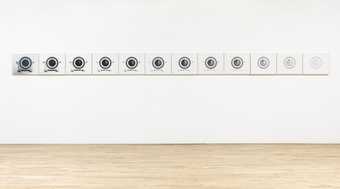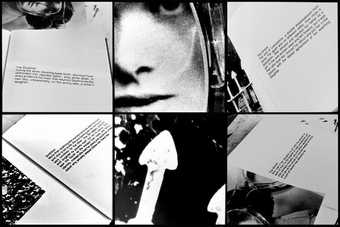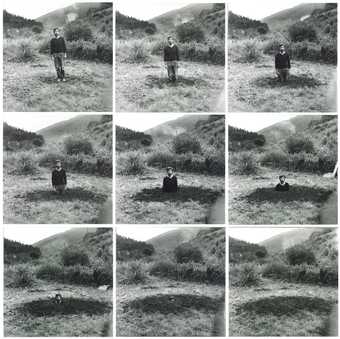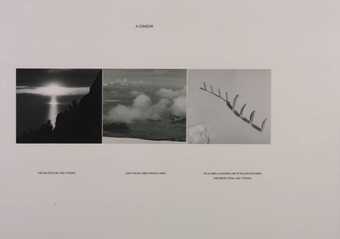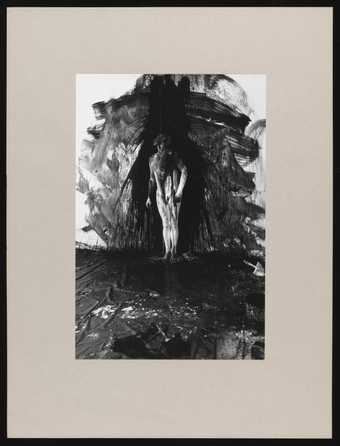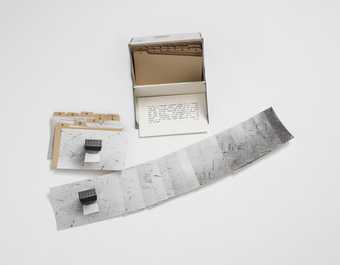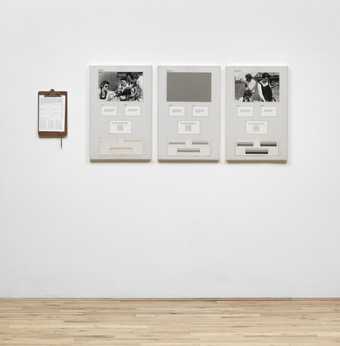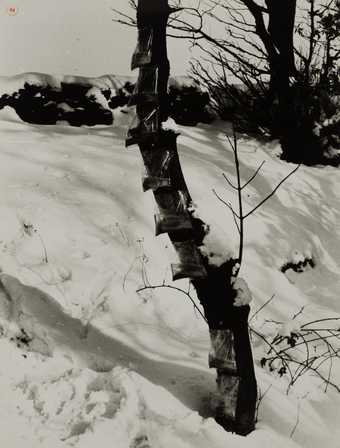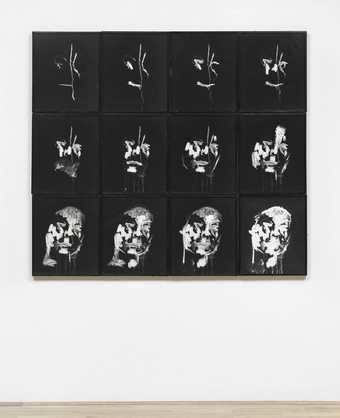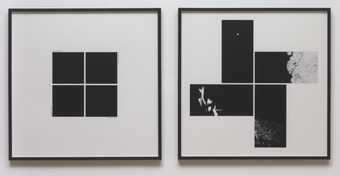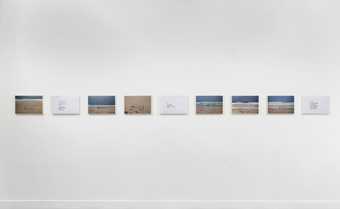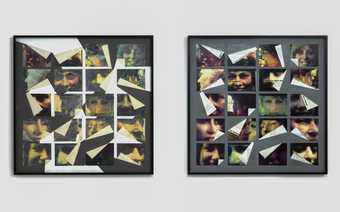
In Tate Liverpool
- Artist
- John Hilliard born 1945
- Medium
- 70 photographs, gelatin silver prints on paper on card on perspex
- Dimensions
- Image: 2174 × 1832 mm
(upper panel: 1075 × 1832 mm , bottom panel: 1075 × 1832 mm) - Collection
- Tate
- Acquisition
- Presented by Colin St John Wilson 1980
- Reference
- T03116
Display caption
Conceptual art became a dominant movement in the 1970s as artists rejected traditional practices for an art that reflected upon the protocols of art itself. For many conceptual artists, the grid functions as rigorous scaffolding for the expressions of basic ideas, articulated with or without limited aesthetic intervention. The idea of a camera examining itself might be seen to epitomise such a practice. Here the camera serves as a device as well as the central image; 70 photographs were taken using mirrors and combinations of aperture and shutter speed.
Gallery label, September 2016
Does this text contain inaccurate information or language that you feel we should improve or change? We would like to hear from you.
Catalogue entry
T03116 CAMERA RECORDING ITS OWN CONDITION (7 APERTURES, 10 SPEEDS, 2 MIRRORS) 1971
Not inscribed
70 black and white photographs drymounted onto card and mounted on perspex, each photograph 7 3/4 × 9 1/2 (19.6 × 24.2), overall dimensions 85 5/8 × 72 1/8 (217.5 × 183.3)
Presented by Professor Colin St John Wilson 1980
Prov:
Professor Colin St John Wilson, 1972–80 (purchased from the artist)
Exh: John Hilliard, Kunstverein, Cologne, November 1983–January 1984, Kunsthalle, Bremen, March–April 1984, Kunstverein, Frankfurt, May–June 1984 (9, repr.)
Lit: Anne Seymour, ‘John Hilliard’ in catalogue for The New Art, Hayward Gallery, August–September 1972, p.98; The Tate Gallery 1972–4, Biennial Report and Illustrated Catalogue of Acquisitions, 1975, pp.167–9; Richard Cork, ‘From Sculpture to Photography, John Hilliard and the Issue of Self-Awareness in Medium Use’, Studio International, CXC, 1975, p.64, small version repr.p.65 and detail on cover; ‘John Hilliard’, interview with Luca Venturi in December 1974 published in catalogue for Arte Inglese Oggi 1960–76, Palazzo Reale, Milan, February–March 1976, pp.387–8, repr.p.389
Repr: Studio International, clxxxiii, 1972, p.170 (small version)
In 1969 John Hilliard exhibited signed photographs of earlier installations, as art objects in their own right, alongside works in three dimensions, and by 1970 was making only photo-based works.
'Camera Recording its Own Condition’ is an important example of Hilliard's early serial photographic works. These were chiefly made between 1970–3, and concentrate on the camera itself as a mechanical device, usually subjecting a repeated image to a predetermined and technically dictated set of conditions, demonstrating in serial form the controls operating in ‘basic’ photography, before any aesthetic intervention has taken place. In these early works the imagery in each photograph will often directly reflect and report on the technical or chemical conditions which caused the final photographs to appear as they do, (e.g. light readings, shutter speeds, printing).
The central image in this work, visible in varying degrees across seventy black and white photographs, arrayed in ten rows of seven across, is the artist's camera, an East German made Praktica. The camera, which is operated by Hilliard, is reflected in two mirrors, the larger of which presents a reversed image of the subject. Hilliard also holds up a smaller mirror which reflects and makes legible the camera's setting and controls. The variables governing the making of the work are indicated by the second part of its title, ‘7 apertures, 10 speeds, 2 mirrors’ - the camera has become both the subject and object of the work, in that the seventy photographs show the images resulting from all combinations of aperture size and shutter speed in that camera. Across a diagonal axis, where the exposures are ‘correct’, it is possible to read the camera settings which produced each image. Where the photographs have been sequentially over or under-exposed, the next reading can usually be logically inferred.
Hilliard's first exercise in pure photography, and one which can be directly related to T03116 is ‘Sixty Seconds of Light’ 1970, acquired by the Tate in 1973 (p 07233). This work demonstrates the way a photograph changes when the film is subjected to different time exposures, using as a model twelve images of the same darkroom clock, set at twelve increasing exposure times (from five seconds to one minute).
Other related works are ‘Thirty-Six Views’ 1970–1 (where the head of a sitter is charted through a rotation of 360° in thirty-six photographs) and a work still owned by the artist, ‘Sixty-Three Ways of Looking at Jeanie’ 1971. This shows sixty-three shots of a girl standing in the centre of a path. As the light changes, so the photographs register lighter or darker. The figure also moves her position slightly within each frame.
A set of contemporary serial works, which at the same time anticipated Hilliard's later more homogenous landscape-based photographs, were the three works in the ‘Ten Runs Past a Fixed Point 1/500 to 1 Second’ series of 1971. (The third version is in the collection of the Arts Council). Here the artist worked with a fixed and a hand held camera, running ten times past a fixed point to be photographed, then reversing this procedure by photographing a fixed point while running past it. The final work in the set amalgamates these procedures, showing photographs being taken from a fixed position of Hilliard running while himself taking ten photographs.
The last work which can be directly related to T03116 is ‘Twelve Representations of White (Reversal Film Stock)’ 1972 (see catalogue entry for P07233), which charts twelve brands of colour film in twelve photographs of a white wall. This work is now in the collection of the Toulon Museum.
'Camera Recording its Own Condition...’, which was never exhibited prior to its arrival at the Tate, was made first in a small version, measuring approximately 20 × 16 in., which remains with the artist. It was a photograph of this version which first appeared in Studio International in 1972 (op.cit). Professor St John Wilson, who afterwards presented T03116 to the Tate, saw the reproduction in Studio and asked Hilliard to make him a full-scale version, which he then purchased from the artist.
The artist used two rolls of 35mm. film for the original maquette, and for the larger version the printing was done by a firm of commercial printers, Gordon Bishop Associates of Paddington. The prints were made using a glossy double-weight paper which was drymounted onto board and heat-sealed. They were then attached to a sheet of perspex.
When correctly displayed, the wall behind the work (which should be painted a neutral colour) is visible between the grid formed by the photographs. The perspex should be attached to the wall by unobtrusive transluscent fittings, and the work positioned no higher than 19 1/2 inches from the floor.
This entry has been approved by the artist.
Published in:
The Tate Gallery 1980-82: Illustrated Catalogue of Acquisitions, London 1984
Explore
- abstraction(8,615)
-
- non-representational(6,161)
-
- geometric(3,072)
- formal qualities(12,454)
-
- light(150)
- photographic(4,673)
- repetition(391)
- art and craft(2,383)
-
- photography(50)
- scientific and measuring(791)
-
- camera(177)
You might like
-
Victor Burgin Lei-feng
1973–4 -
John Hilliard Sixty Seconds of Light
1970 -
Marie Yates The Only Woman
1984, partly reprinted 2019 -
John Hilliard Seven Representations of White
1972 -
Keith Arnatt Self-Burial (Television Interference Project)
1969 -
Hamish Fulton A Condor
1972 -
Stuart Brisley Moments of Decision/Indecision
1975 -
Victor Burgin 25 feet two hours
1969 -
Stephen Willats ‘The Lunch Triangle’: Pilot work B. Codes and Parameters
1974 -
Ed Herring Tea-bag Piece
1968–9 -
Sue Arrowsmith Andromeda’s Tear
1982 -
Sue Arrowsmith Without Title (White Frame / Black Frame)
1969 -
John Hilliard Black Depths
1974 -
Marie Yates Field Working Paper 7 - 26th April 1972 - Porthmeor Beach, St.Ives, Cornwall
1972–2016 -
Marie Yates Image/woman/text
1979


